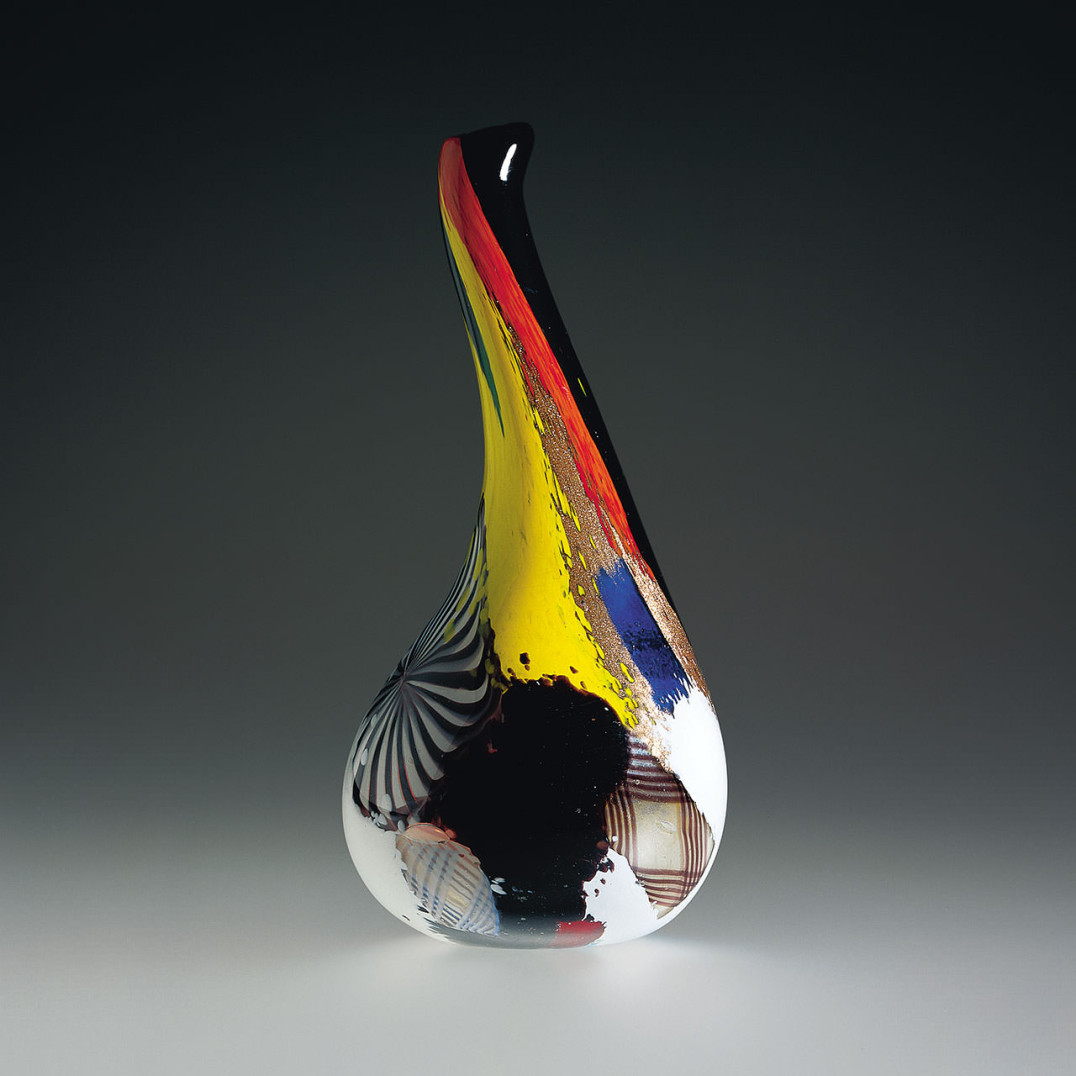
Dino MartensOriente, 1952
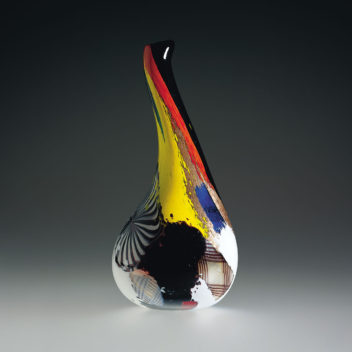
Dino MartensOrienteAureliano Toso Vetri Decorativi, 1952
Vessel from the Oriente series. This model, also known as Olaf, made with irregular patches of multicolored glass, inclusions of avventurina and canes of zanfirico and reticello.
Vessel conforms with model n. 3122 of the manufacturer’s catalogue.
14 in. high (35.5 cm)
Exhibitions:
1952, Venice, 26th Biennale Internazionale d’Arte;
2000, New York, Venetian Glass, Museum of Arts & Design;
2001, Milan, Murano: Vetri dalla Collezione Olnick Spanu, Spazio Oberdan.
Bibliography and comparative texts:
Mille anni…, 1982, n. 615;
Intérieurs ’50, 1983, n. 137;
W. Neuwirth, 1987, n. 95;
M. Heiremans, 1989, n. 136;
R. Barovier Mentasti, 1992, n. 104;
M. Heiremans, 1993, nn. 155, 157, 161, 162;
M. Barovier, 1994, nn. 27–29;
Venezia e la Biennale…, 1995, n. 486;
F. Deboni, 1996, nn. 152, 153.
M. Heiremans, 1996, nn. 122-124;
H. Ricke, E. Schmitt, 1996, nn. 203-206;
L.M. Barbero, 1997, p. 231;
M. Barovier, 1999, p. 217;
M. Heiremans, 1999, n. 43;
Olnick Spanu, 2000, n. 110-111;
R. Reif, New York Times, 2000, p. 39;
Olnick Spanu, 2001, n. 147.
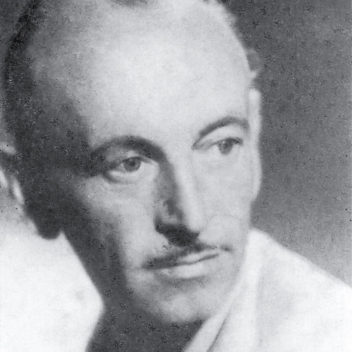
Dino Martens 1894–1970
Painter and designer Dino Martens was born in Venice, where he attended the Accademia di Belle Arti. In the mid '20s he moved to Murano, where for a short time he was a partner and decorator for the glass factory S.A.L.I.R. Later he worked as a designer for Salviati & C. and its successor Andrea Rioda. His Novecento-style paintings were exhibited at the Biennale di Venezia between 1924 and 1930. Upon his return from the African War in 1939, he became artistic director of the glass factory Aureliano Toso. From 1946 to 1960, Martens designed an incredible series of works for Toso. Using traditional Venetian techniques, he was able to obtain strikingly original multicolored effects combined with particularly daring asymmetric shapes. They included the compositions of glass rods called zanfirici; colorful pieces composed with irregular shadings, and inserts of avventurina and rods of filigrana called Oriente; as well as the unusual shapes of the Sommersi with battuto finish and the inside cased with multicolored glass. His collaboration with the Aureliano Toso ended in 1963.
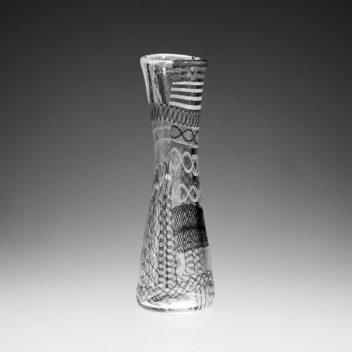
Aureliano Toso Vetri Decorativi 1932–
Founded in 1938 by Aureliano Toso, Aureliano Toso Vetri Decorativi boasted the artistic direction of Dino Martens, a painter from Murano, who worked with the company until 1965. The works created by Martens brought widespread acclaim at the major exhibitions of decorative arts, the colors being of particular interest. In 1962, the company sought the collaboration of outside consultants like Enrico Potz. After 1966, the artistic direction was entrusted to Gino Poli, who designed, among others, the collection A Solchi Colorati. Later, the company turned to the production of glass parts for lighting, which it still produces today.
Dino MartensOriente, 1952
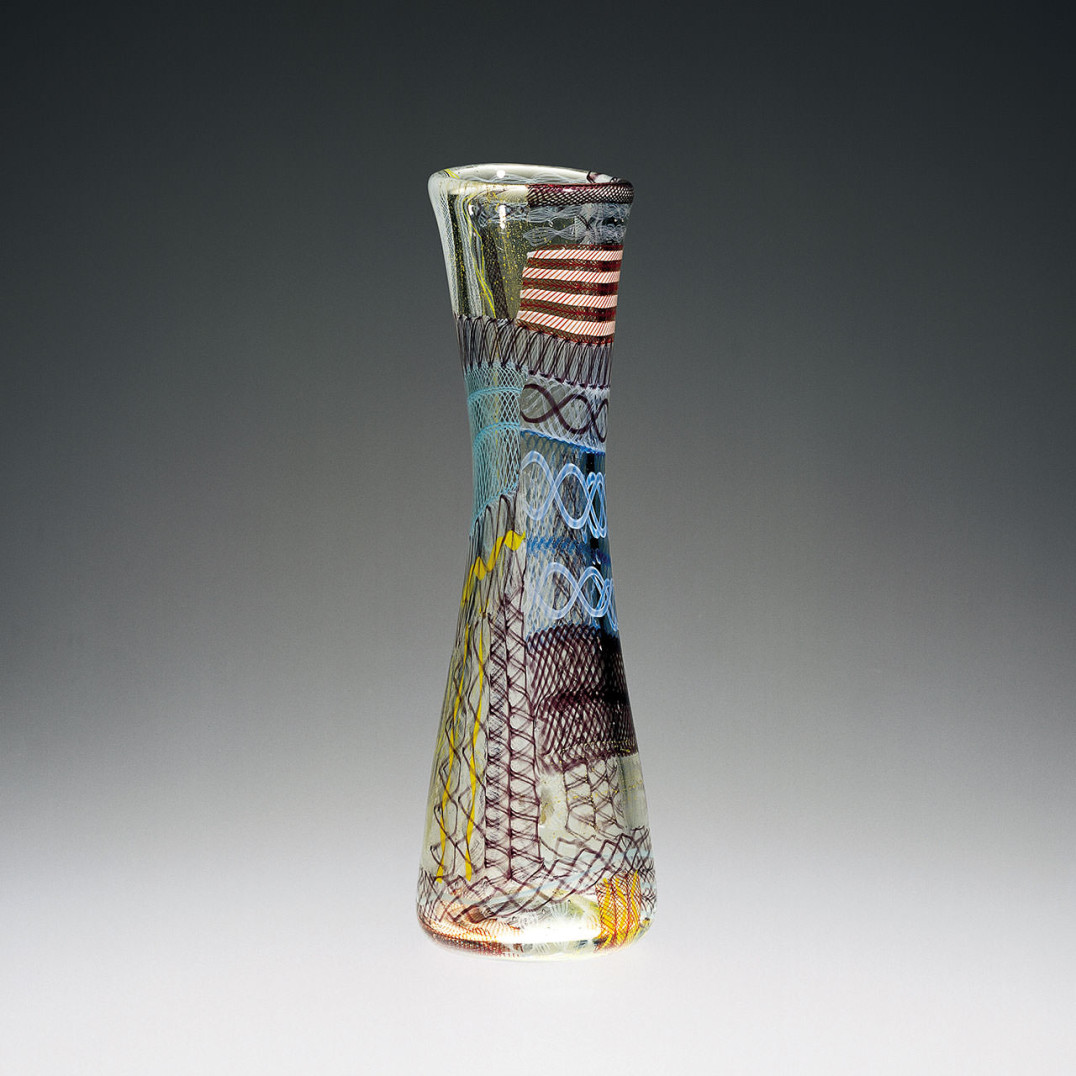
Dino MartensZanfirico, 1952

Dino MartensZanfiricoAureliano Toso Vetri Decorativi, 1952
Vase from the zanfirico series, the clear glass decorated with multicolored canes of zanfirico and reticello glass.
Original paper label: Anita Kott Importer.
14 3/16 in. high (36 cm)
Exhibitions:
1952, Venice, 26th Biennale Internazionale d’Arte;
2000, New York, Venetian Glass, Museum of Arts & Design;
2001, Milan, Murano: Vetri dalla Collezione Olnick Spanu, Spazio Oberdan.
Bibliography and comparative texts:
R. Aloi, 1952, n. 20;
R. Aloi, 1955, p. 31;
M. Heiremans, 1989, nn. 146, 147;
M. Heiremans, 1993, nn. 156, 166;
M. Barovier, 1994, n. 26;
M. Barovier, R. Barovier Mentasti, A. Dorigato, 1995, n. 97;
F. Deboni, 1996, p. 63, n. 150;
M. Heiremans, 1996, n. 103;
Olnick Spanu, 2000, n. 109;
Olnick Spanu, 2001, n. 146.

Dino Martens 1894–1970
Painter and designer Dino Martens was born in Venice, where he attended the Accademia di Belle Arti. In the mid '20s he moved to Murano, where for a short time he was a partner and decorator for the glass factory S.A.L.I.R. Later he worked as a designer for Salviati & C. and its successor Andrea Rioda. His Novecento-style paintings were exhibited at the Biennale di Venezia between 1924 and 1930. Upon his return from the African War in 1939, he became artistic director of the glass factory Aureliano Toso. From 1946 to 1960, Martens designed an incredible series of works for Toso. Using traditional Venetian techniques, he was able to obtain strikingly original multicolored effects combined with particularly daring asymmetric shapes. They included the compositions of glass rods called zanfirici; colorful pieces composed with irregular shadings, and inserts of avventurina and rods of filigrana called Oriente; as well as the unusual shapes of the Sommersi with battuto finish and the inside cased with multicolored glass. His collaboration with the Aureliano Toso ended in 1963.

Aureliano Toso Vetri Decorativi 1932–
Founded in 1938 by Aureliano Toso, Aureliano Toso Vetri Decorativi boasted the artistic direction of Dino Martens, a painter from Murano, who worked with the company until 1965. The works created by Martens brought widespread acclaim at the major exhibitions of decorative arts, the colors being of particular interest. In 1962, the company sought the collaboration of outside consultants like Enrico Potz. After 1966, the artistic direction was entrusted to Gino Poli, who designed, among others, the collection A Solchi Colorati. Later, the company turned to the production of glass parts for lighting, which it still produces today.
Dino MartensZanfirico, 1952

Dino MartensEldorado, 1952-1954
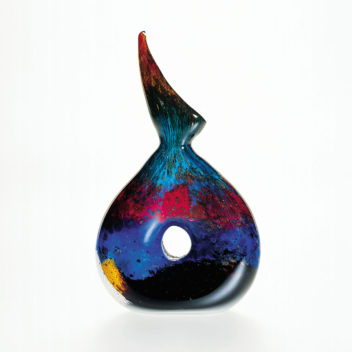
Dino MartensEldoradoAureliano Toso Vetri Decorativi, 1952-1954
A vase from the Eldorado series crafted with a central aperture. Composed of multicolored ground powders and avventurina glass with inclusions of canes in zanfirico
and reticello.
This model conforms
to n. 5252 in the Aureliano Toso catalogue.
11 7/8 in. high (30.2 cm)
Exhibitions:
1952, Venice, 26th Biennale Internazionale d’Arte;
2000, New York, Venetian Glass, Museum of Arts & Design;
2001, Milan, Murano: Vetri dalla Collezione Olnick Spanu, Spazio Oberdan.
Bibliography and comparative texts:
R. Aloi, 1955, p. 30;
M. Heiremans, 1993, nn. 163, 164;
M. Barovier, 1994, n. 25;
M. Heiremans, 1996, nn. 144, 145;
H. Ricke, E. Schmitt, 1996, n. 210;
L.M. Barbero, 1997, p. 231;
M. Barovier, 1999, p. 215.
M. Heiremans, 1999, p. 166;
Olnick Spanu, 2000, n. 108;
Olnick Spanu, 2001, n. 145.

Dino Martens 1894–1970
Painter and designer Dino Martens was born in Venice, where he attended the Accademia di Belle Arti. In the mid '20s he moved to Murano, where for a short time he was a partner and decorator for the glass factory S.A.L.I.R. Later he worked as a designer for Salviati & C. and its successor Andrea Rioda. His Novecento-style paintings were exhibited at the Biennale di Venezia between 1924 and 1930. Upon his return from the African War in 1939, he became artistic director of the glass factory Aureliano Toso. From 1946 to 1960, Martens designed an incredible series of works for Toso. Using traditional Venetian techniques, he was able to obtain strikingly original multicolored effects combined with particularly daring asymmetric shapes. They included the compositions of glass rods called zanfirici; colorful pieces composed with irregular shadings, and inserts of avventurina and rods of filigrana called Oriente; as well as the unusual shapes of the Sommersi with battuto finish and the inside cased with multicolored glass. His collaboration with the Aureliano Toso ended in 1963.

Aureliano Toso Vetri Decorativi 1932–
Founded in 1938 by Aureliano Toso, Aureliano Toso Vetri Decorativi boasted the artistic direction of Dino Martens, a painter from Murano, who worked with the company until 1965. The works created by Martens brought widespread acclaim at the major exhibitions of decorative arts, the colors being of particular interest. In 1962, the company sought the collaboration of outside consultants like Enrico Potz. After 1966, the artistic direction was entrusted to Gino Poli, who designed, among others, the collection A Solchi Colorati. Later, the company turned to the production of glass parts for lighting, which it still produces today.
Dino MartensEldorado, 1952-1954
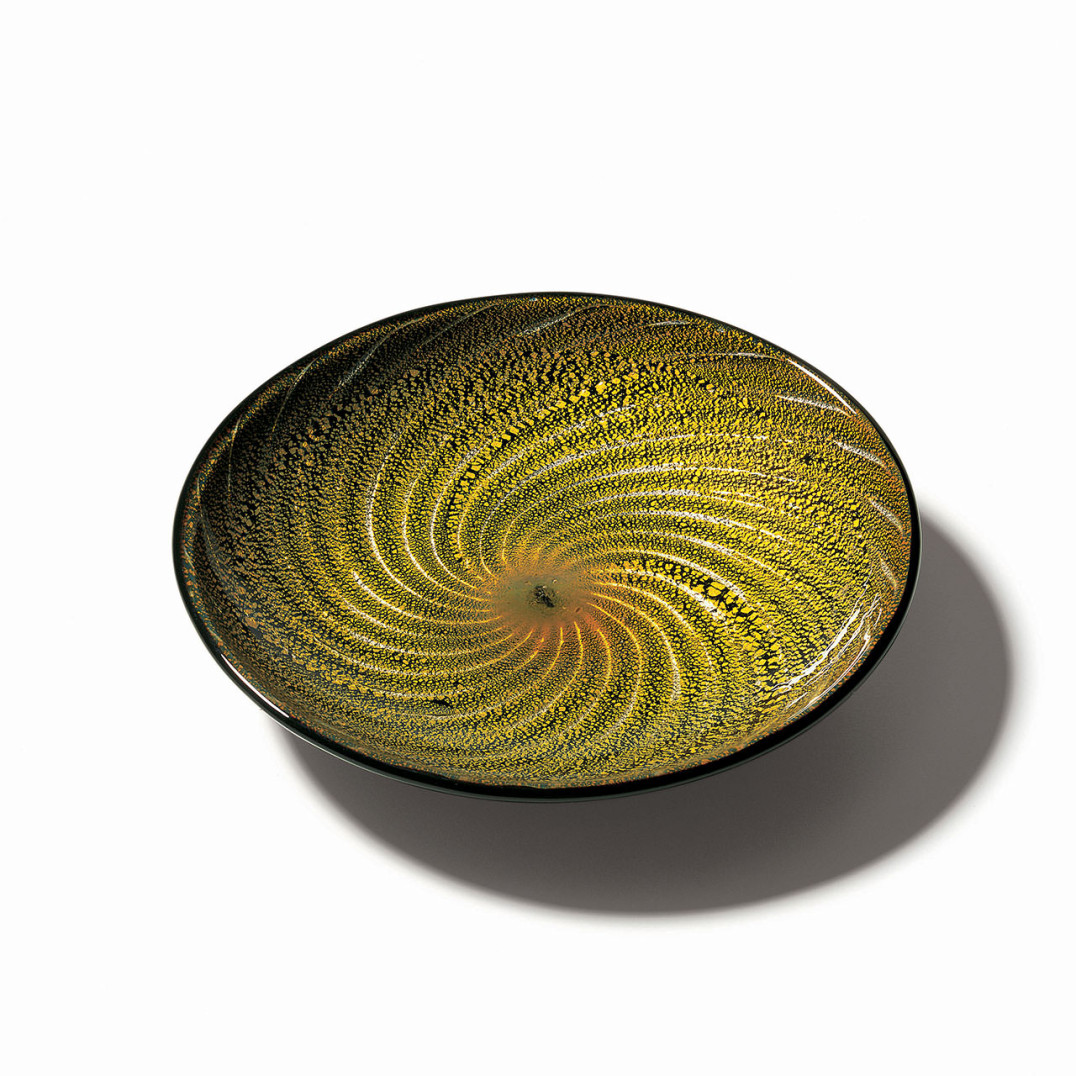
Giulio RadiReazioni policrome, 1952
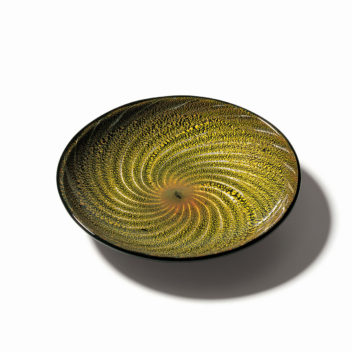
Giulio RadiReazioni policromeA.VE.M., 1952
A reazioni policrome plate crafted
in aubergine glass with applications of gold leaf. The multicolored effects are due to the specific reactions of the added metallic oxides.
Ø; 9 1/4 in. (23.5 cm)
Exhibitions:
1952, Venice, 26th Biennale Internazionale d’Arte;
2000, New York, Venetian Glass, Museum of Arts & Design;
2001, Milan, Murano: Vetri dalla Collezione Olnick Spanu, Spazio Oberdan.
Bibliography and comparative texts:
Venezianisches…, 1981, n. 127;
Mille anni…, 1982, n. 570;
R. Barovier Mentasti, 1982, n. 296;
Vetro di Murano, 1982, nn. 147, 148;
W. Neuwirth, 1987, p. 194;
M. Heiremans, 1989, n. 9;
M. Barovier, R. Barovier Mentasti,
A. Dorigato, 1995, n. 89;
M. Barovier, 1999, p. 190;
Olnick Spanu, 2000, n. 107;
Olnick Spanu, 2001, n. 144;
A. Dorigato, 2002, p. 323.

Giulio Radi 1895–1952
Glass technician, designer, and entrepreneur Giulio Radi was born in Murano into a family of renowned glass technicians. His first work experience was in his father's furnace, then in the furnace of Andrea Rioda. In 1921, he became one of the founders of the Successori Andrea Rioda, where his role was primarily administrative. He left the company in 1932 to become one of the founding partners of A.VE.M., where he became artistic director in 1939. It is here that he began an intense period of design and experimentation with glass. He devoted his research in particular to the field of metal oxides, where he discovered precious coloring techniques by using murrine and gold and silver dust on simple and suggestive shapes. His work was interrupted by his premature death in 1952. Assiduosly avoiding the camera, this is the only photo known to exist of the artist.

A.VE.M. 1932–
A.VE.M. was founded in 1932 by Antonio Luigi Ferro, his son Egidio, and the maestri glassblowers Emilio Nason, Galliano Ferro, and Giulio Radi. During the '30s the furnace, which was capable of producing refined Venetian glass techniques, worked with Vittorio Zecchin, who created lightweight blown glass pieces, and Emilio Nason, who created Novecento-style sculptures. After 1939, Giulio Radi became artistic director and dedicated himself predominantly to experimenting with metal oxides. After Radi's premature death in 1952, Giorgio Ferro replaced him and acted as artistic director through 1955, the year he left to found a new furnace with his father, Galliano. During the '50s, A.VE.M. collaborated with the painter Luigi Scarpa Croce, and later the designer Anzolo Fuga. Between 1966 and 1972 several collections were designed by the glassmaster Luciano Ferro. A.VE.M. is still active in Murano today.
Giulio RadiReazioni policrome, 1952

Giorgio FerroAnse volanti, 1952
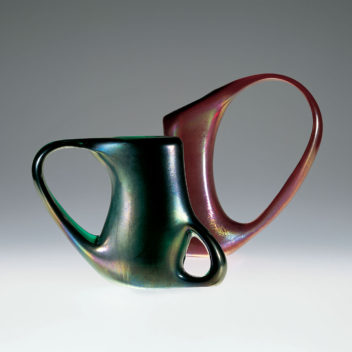
Giorgio FerroAnse volantiA.VE.M., 1952
Glass vessels, one crafted with the use of red trasparente glass, the other in green trasparente glass. Both are heavily iridized. They are typified by their large side handles made by piercing the wall of
the object.
7 1/2 in. high (19 cm)
10 1/2 in. high (26.7 cm)
Exhibitions:
1952, Venice, 26th Biennale Internazionale d’Arte;
2000, New York, Venetian Glass, Museum of Arts & Design;
2001, Milan, Murano: Vetri dalla Collezione Olnick Spanu, Spazio Oberdan.
Bibliography and comparative texts:
B. Nerozzi, 1987, n. 53;
W. Neuwirth, 1987, n. 231;
M. Heiremans, 1989, nn. 3-5;
L’arte del vetro…, 1992, n. 376;
R. Barovier Mentasti, 1992, n. 95;
M. Barovier, R. Barovier Mentasti, A. Dorigato, 1995, n. 90;
Venezia e la Biennale…, 1995, n. 469;
F. Deboni, 1996, p. 23;
H. Ricke, E. Schmitt, 1996, n. 172;
M. Barovier, 1999, p. 191;
Olnick Spanu, 2000, n. 106;
Olnick Spanu, 2001, n. 143;
A. Dorigato, 2002, p. 324.
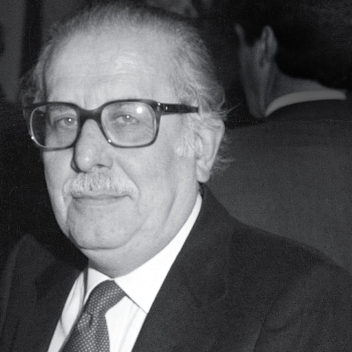
Giorgio Ferro 1931–
Born in Murano and the son of the glassmaker Galliano Ferro, Giorgio Ferro attended the Istituto d'Arte di Venezia, dedicating himself initially to painting. He soon went to work as a designer at the Vetreria A.VE.M. where his father had become a partner after the death of its artistic director Giulio Radi (1952). His most significant work of the period is a piece called Anse Volanti, dark colored vessels with iridescent surfaces and ample handles obtained hot directly from the body, which produces a remarkable sculptural effect. When his father, Galliano, left A.VE.M. in 1955 to found his own company, he followed him to become the artistic director of the new furnace, and designed thin blown pieces as well as essentially shaped encased glass pieces. He has been owner of Galliano Ferro since 1972.

A.VE.M. 1932–
A.VE.M. was founded in 1932 by Antonio Luigi Ferro, his son Egidio, and the maestri glassblowers Emilio Nason, Galliano Ferro, and Giulio Radi. During the '30s the furnace, which was capable of producing refined Venetian glass techniques, worked with Vittorio Zecchin, who created lightweight blown glass pieces, and Emilio Nason, who created Novecento-style sculptures. After 1939, Giulio Radi became artistic director and dedicated himself predominantly to experimenting with metal oxides. After Radi's premature death in 1952, Giorgio Ferro replaced him and acted as artistic director through 1955, the year he left to found a new furnace with his father, Galliano. During the '50s, A.VE.M. collaborated with the painter Luigi Scarpa Croce, and later the designer Anzolo Fuga. Between 1966 and 1972 several collections were designed by the glassmaster Luciano Ferro. A.VE.M. is still active in Murano today.